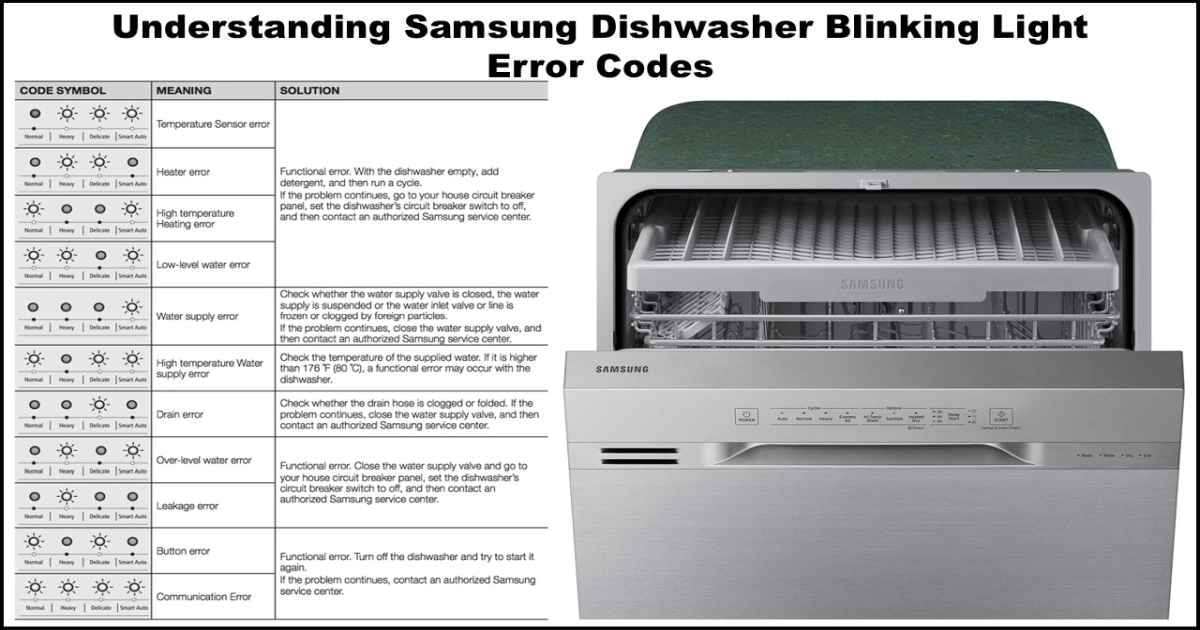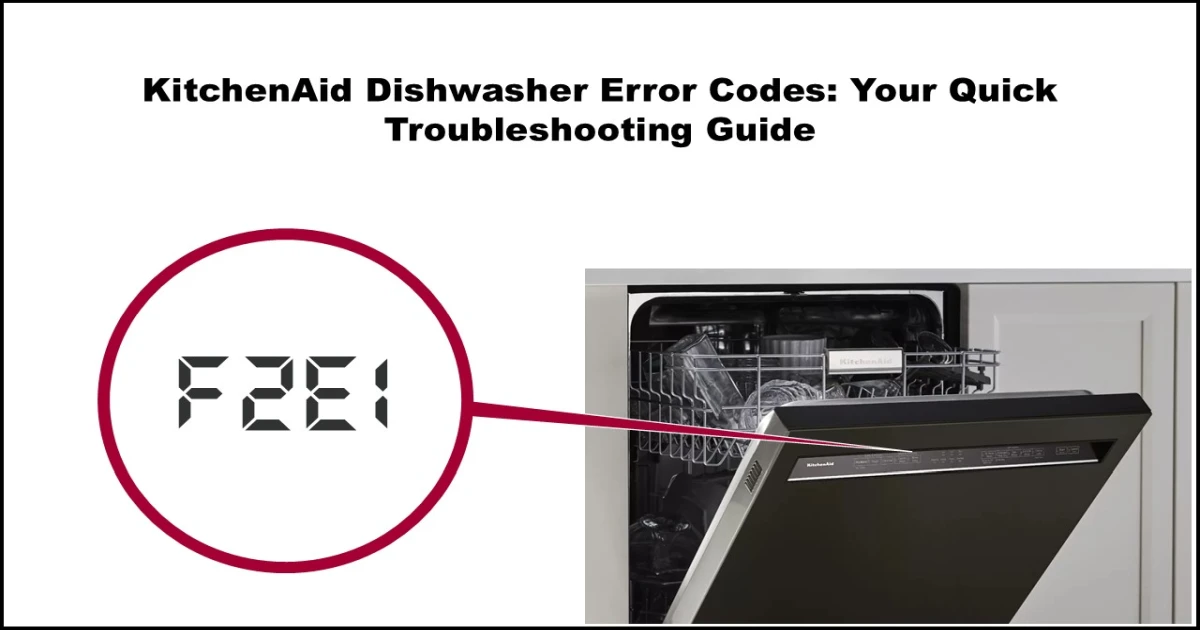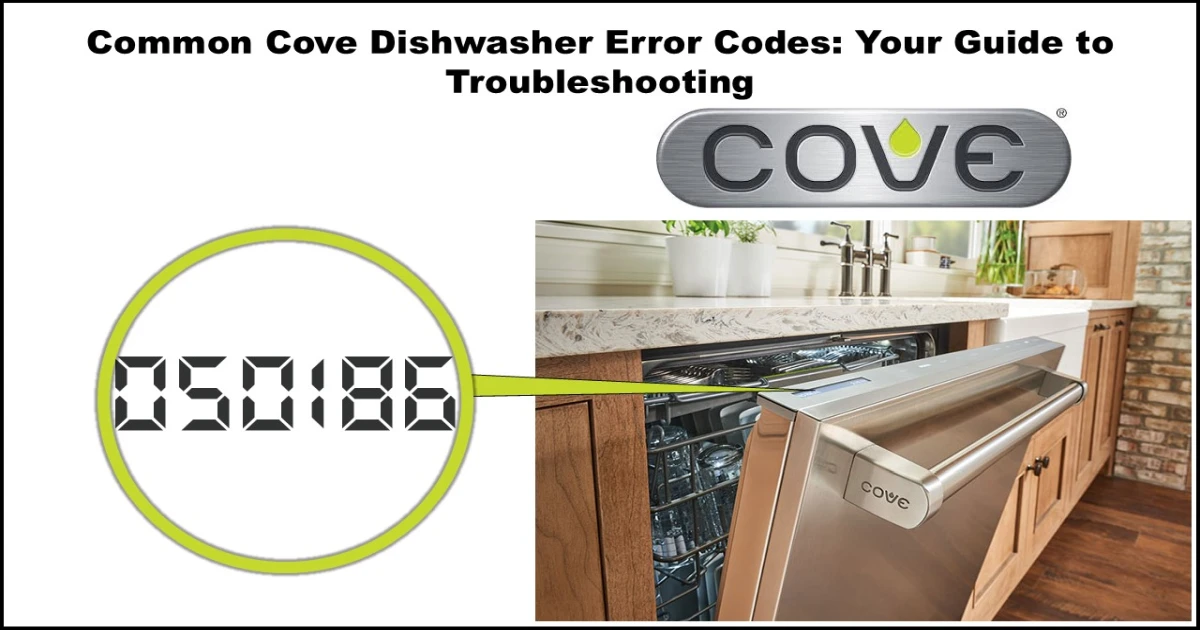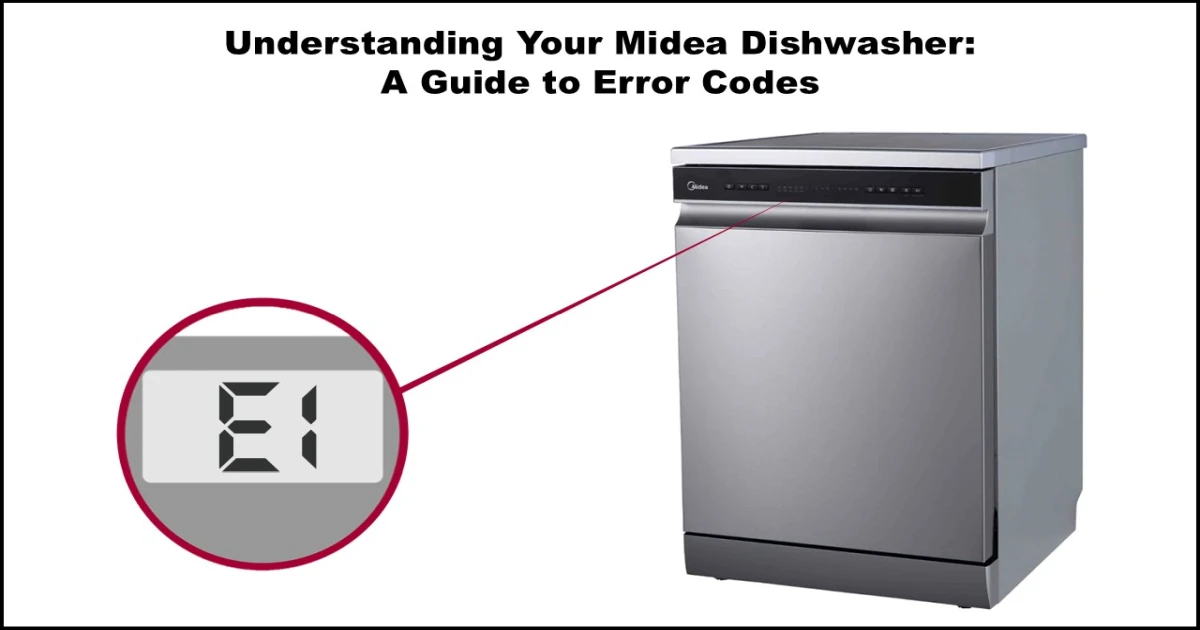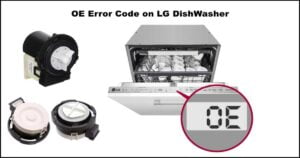Uh oh! Is your Samsung dishwasher showing an error code? Here’s What to Do.
Seeing an error code flashing on your Samsung dishwasher can be frustrating, but don’t panic! These codes are the dishwasher’s way of telling you something specific needs attention. Often, it’s an issue you can resolve yourself with a bit of troubleshooting.
This guide will help you troubleshoot most Samsung dishwasher error codes, understand the potential problem, and walk you through the steps to hopefully get it back on track.
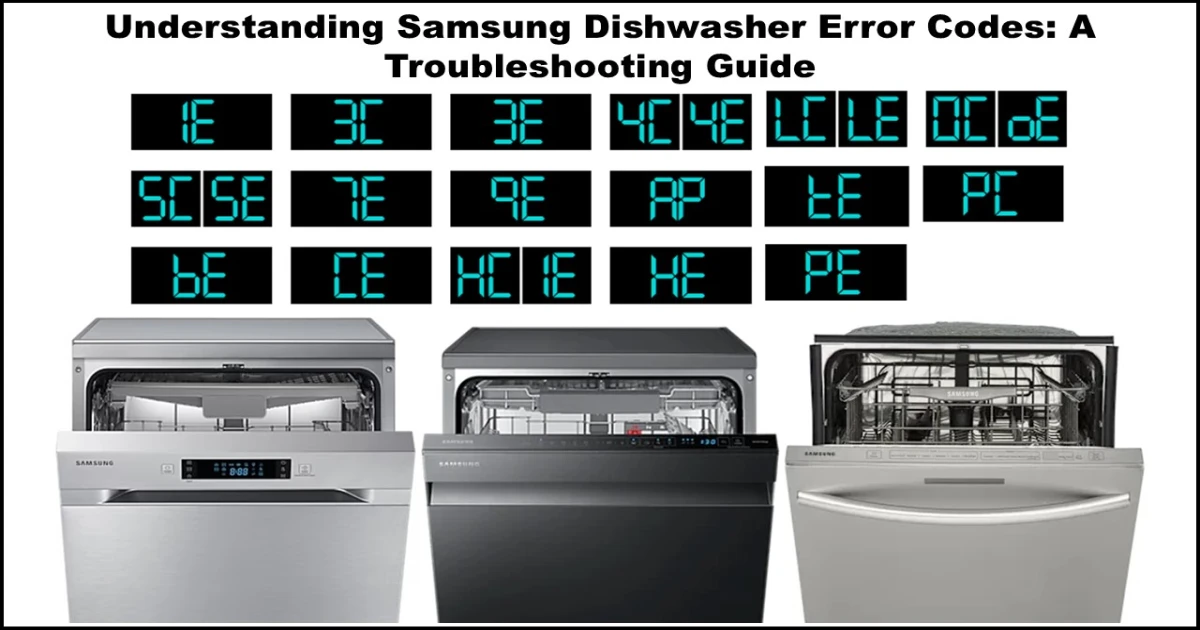
Important Safety Note: Before attempting any troubleshooting that involves reaching into the dishwasher or checking connections, it’s always a good idea to turn off the power to the dishwasher at your circuit breaker for safety.
Common Samsung Dishwasher Error Codes Explained:
Water Flow & Drainage Issues:
Error Code: 1E / IE (Waterwall Clogged Filter)
- Problem: Water isn’t flowing correctly through the filter system.
- Troubleshooting:
- Carefully locate and remove the fine filter, usually found at the bottom of the dishwasher tub.
- Clean the filter thoroughly under running water, removing any food particles or debris.
- Reinstall the filter correctly.
Error Code: 4C / 4E – Water Supply Error
- Problem: The dishwasher isn’t receiving water, or the water pressure/temperature isn’t correct.
- Troubleshooting:
- Check that the main water supply valve connected to the dishwasher (often under the sink) is fully turned on.
- Verify your home’s water pressure meets the requirements listed in your dishwasher manual.
- Ensure the incoming water temperature isn’t excessively high or low (check the manual for specifics; generally, below 120°F/49°C is recommended for optimal performance, though some errors trigger at higher temps like 176°F/80°C – see 3E).
- Important: Samsung dishwashers are generally not compatible with Floodsafe® or other flood-prevention hoses. These can restrict water flow and trigger this error. Use a standard dishwasher supply hose.
Error Code: 5C / SC / 5E / SE – Drain Error
- Problem: The dishwasher is unable to drain the water out.
- Troubleshooting:
- Check Sink Drain: Ensure the sink drain where the dishwasher hose connects isn’t clogged. Run the garbage disposal (if you have one) before starting the dishwasher. Ensure the knockout plug inside the garbage disposal inlet nipple was removed when the dishwasher was installed.
- Inspect Drain Hose: Look for kinks or blockages in the dishwasher’s drain hose running from the dishwasher to the sink drain or disposal.
- Clean Internal Components: Remove and clean the dishwasher’s filter and check the sump area (where the filter sits) for debris.
Error Code: 9E – Low Water Level Error
- Problem: The dishwasher detects insufficient water inside during the cycle.
- Troubleshooting:
- Empty the dishwasher completely.
- Add the correct amount of detergent.
- Run a normal cycle. If the error persists, it could indicate a water supply issue (see 4C/4E) or a sensor problem.
Error Code: OC / 0C / oE – Over-Level Water Error
- Problem: There’s too much water in the dishwasher tub. This is often linked to a draining problem.
- Troubleshooting: Follow the same steps as the 5C/SC/5E/SE Drain Error above (Check sink drain, inspect drain hose, clean filter/sump).
Error Code: LC / LE – Leakage Error
- Problem: The dishwasher’s leak sensor detects moisture in the base, or (on Waterwall models) the water reflector might be blocked. The dishwasher may turn on by itself and try to drain continuously as a safety measure.
- Troubleshooting:
- Check for Leaks: Carefully inspect under and around the dishwasher for any signs of water leaks. Check hoses and connections. If you see a leak, turn off the water supply and power and call for service.
- No Visible Leak?
- If the dishwasher was recently moved or installed, water might have splashed near the sensor. Allow time for it to dry out completely (you may need to unplug it or turn off the breaker if the draining noise is constant).
- Ensure the detergent dispenser wasn’t overfilled or spilled, which can cause excessive suds that mimic leaks. Use the correct amount of appropriate dishwasher detergent.
- On Waterwall models, ensure the water reflector at the bottom is correctly installed and not blocked.
- If connected to a garbage disposal, double-check the knockout plug was removed.
Heating & Temperature Issues:
Error Code: 3E – High Temperature Water Supply Error
- Problem: The incoming water is too hot (potentially exceeding 176°F / 80°C).
- Troubleshooting:
- Check the temperature setting on your home’s water heater. Lower it if it’s set excessively high. Very hot water can damage the dishwasher over time.
Error Code: HC/1E/IE (Rotary Models)—High Temperature Heater Error
- Problem: The internal temperature is detected as being too high.
- Troubleshooting:
- Power Cycle: Turn off the dishwasher’s power at the circuit breaker for 30-60 seconds, then turn it back on.
- Empty the dishwasher.
- Add detergent and run a Normal cycle. If the error returns, it may indicate a faulty thermostat or heating element.
Error Code: HE – Heater Error
- Problem: The dishwasher is having trouble detecting or regulating the water temperature correctly (potentially a heater element or thermostat issue).
- Troubleshooting:
- Empty the dishwasher.
- Add detergent.
- Run a normal cycle. If the error persists after a power cycle (turn off at breaker for a minute), service may be required.
Error Code: tE – Temperature Sensor Error
- Problem: The dishwasher’s temperature sensor (thermistor) may be malfunctioning.
- Troubleshooting:
- Empty the dishwasher.
- Add detergent.
- Run a normal cycle. A power cycle (off/on at the breaker) might also help. If the error continues, the sensor likely needs checking or replacement.
Mechanical & Electronic Issues:
Error Code: 3C – Pump Operation Error
- Problem: The dishwasher’s main pump (responsible for spraying water) has likely failed or is malfunctioning.
- Troubleshooting: This error usually requires professional service to inspect or replace the pump motor.
Error Code: 7E – Waterwall Reflector Error (Waterwall Models)
- Problem: The moving spray arm (Waterwall reflector) at the bottom isn’t moving correctly.
- Troubleshooting:
- If the dishwasher is new, ensure all packing tape has been removed from the reflector mechanism.
- Check that the reflector is correctly seated in its position and not obstructed by fallen utensils or debris.
- Make sure it can move back and forth freely by hand (with the power off).
Error Code: bE / 6E – Button Error
- Problem: The control panel thinks one of the buttons is stuck or continuously pressed.
- Troubleshooting:
- Turn the dishwasher off.
- Gently but firmly press and release every single button on the control panel to ensure none are physically stuck.
- Turn the dishwasher back on.
Error Code: CE – Communication Error
- Problem: The main control board is having trouble communicating with the display panel or other components.
- Troubleshooting:
- Try power cycling the dishwasher (turn off power at the circuit breaker for 1 minute, then turn it back on). If the error persists, this usually requires diagnosis by a technician.
Error Code: PC – Zone Wash Error // Error Code: PE – Half Load Function Error
- Problem: An issue detected with the half-load function settings or operation.
Connectivity:
Error Code: AP – Access Point Mode
- Problem: Not really an “error.” The dishwasher is in a special mode used for connecting it to Wi-Fi via a smartphone app (like SmartThings).
- Troubleshooting:
- If you are not trying to connect the dishwasher to Wi-Fi, simply turn the dishwasher off and then back on again using the power button. It should exit AP mode.
When DIY Isn’t Enough
While many errors can be fixed with these simple steps, some codes (like 3C, CE, or persistent heating/sensor errors) often indicate a problem with an internal component that requires professional diagnosis and repair. If you’ve tried the troubleshooting steps for your code and the problem continues, or if you’re uncomfortable performing any of the steps, it’s best to contact Samsung Support or a qualified appliance repair technician.
Remember to always consult your specific dishwasher model’s service manual for detailed information and diagrams. Good luck!
